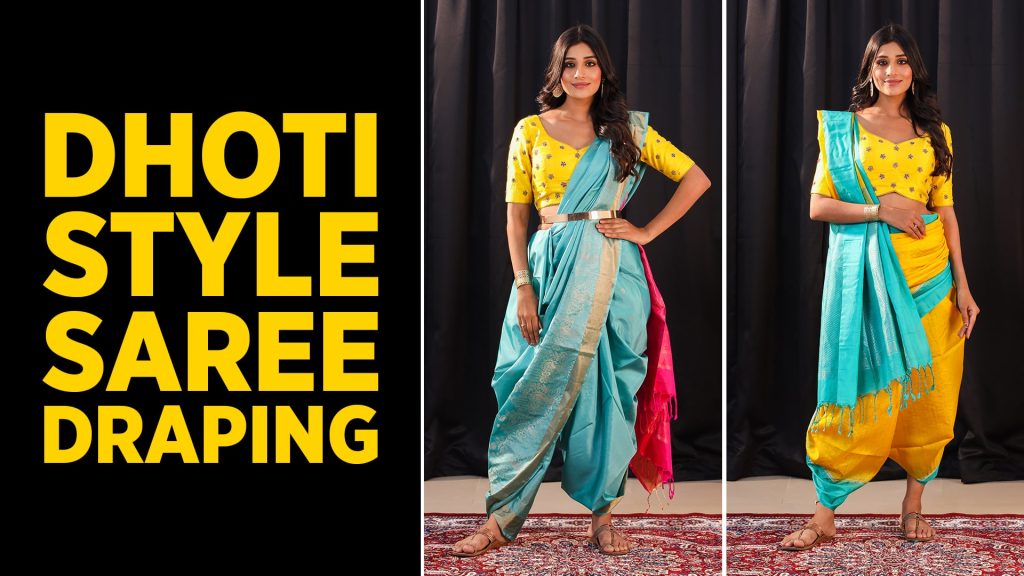So finding it a trend to convert your sarees into a dhoti style saree is really fun and stylish. But does that mean that there’s a limitation to even a dhoti saree drape? Well, NOT Really! With new ways of wearing a dhoti saree, we have brought a mixture of traditional Marathi saree draping with a twist of contemporary style of saree wearing.
Let’s learn how to wear a silk saree into a dhoti saree drape. All we need is a Regular length saree and not a 9 yards saree like what a traditional Nauvari saree draping needs.
We will be using the popular trend of the kasta saree drape. To know exactly what a kasta is, you can read the different types of Kasta Saree draping styles blog post.
So this post and the video below will show you easy techniques for draping a dhoti silk saree look for any occasion.
2 Ways of Dhoti Style Saree Draping for Silk Sarees
STYLE 1 – Front Cowl Dhoti Style Saree Drape
Draping a marathi saree or kasta saree will need leggings or tights and not a petticoat. Get dressed in a pair of those and a saree blouse.
- Next, gather the saree for a wrap around your waist from the back and tie a knot in the center. Keep some fabric on your left ( 1.25m).
- Make a Kasta drape, by pleating saree fabric on the left and take it under your legs from front to back. And tuck at the back waist.
- Now take the fabric on your right and push it to the back, the same way from between your legs. Hold the first top edge or border and pull it to your center back waist. Use a pin to secure it under your kasta drape. (See the Video to understand the kasta drape section)
- Draw the saree to your front and make two-three small pleats and drape them on the same left side waist. Use a pin to secure it. This will create a cowl effect on the center-left side.
- Also, pull the palla top border tightly across the bodice and drape and pin it at the left shoulder.
- Now you will need to create pleats with your hands which may give you a draped cowl pleats effect on the front side.
NOTE – Marathi draping sarees don’t have an equal pleated palla at the ends.
You can always try this with a silk saree blend of flowy fabric like crepe silk saree, and satin silk saree, this will give you a better cowl and dhoti drape effect than other coarser fabrics of silks.
STYLE 2 – Siddha Palla Dhoti Saree Draping
Here’s a variation of a traditional kasta draping saree and a sidha palla drape saree. Combined together with a wrap drape to create a different dhoti saree style. The draping styles are similar till the first kasta drape is done.
- Now take the right side of the saree fabric and make 3 pleats in the center. They should open on the left side and tuck over the knot to hide it.
- Then take the saree under your two legs and pull out from the backside. Again Pin the top border under your kasta tuck.
- Now hold the saree straight to create small pleats and a drape that has its lower saree edge halfway of your knee (don’t combine the saree pleats together you need a triangular drape on your left side. (See the video above for understanding this drape perfectly)
- Now take this whole drape around from front to backside like a belt. And stop on the back right side. Pin the drape in place at the back waist.
- Hold the width of the palla and make even pallu pleats and drape them from back shoulder to front like a gujarati pallu.
- Pin them at the shoulder and adjust the drape of pleats from the back. To have a clean drape look.
- This can be done the same way as the first style by making pleats uneven at the palla or straight as shown in the 2nd drape style.
We love how saree draping is so versatile and just little changes can create stylish Indo western party wear dhoti saree look. See more draping saree styles on our blog.

